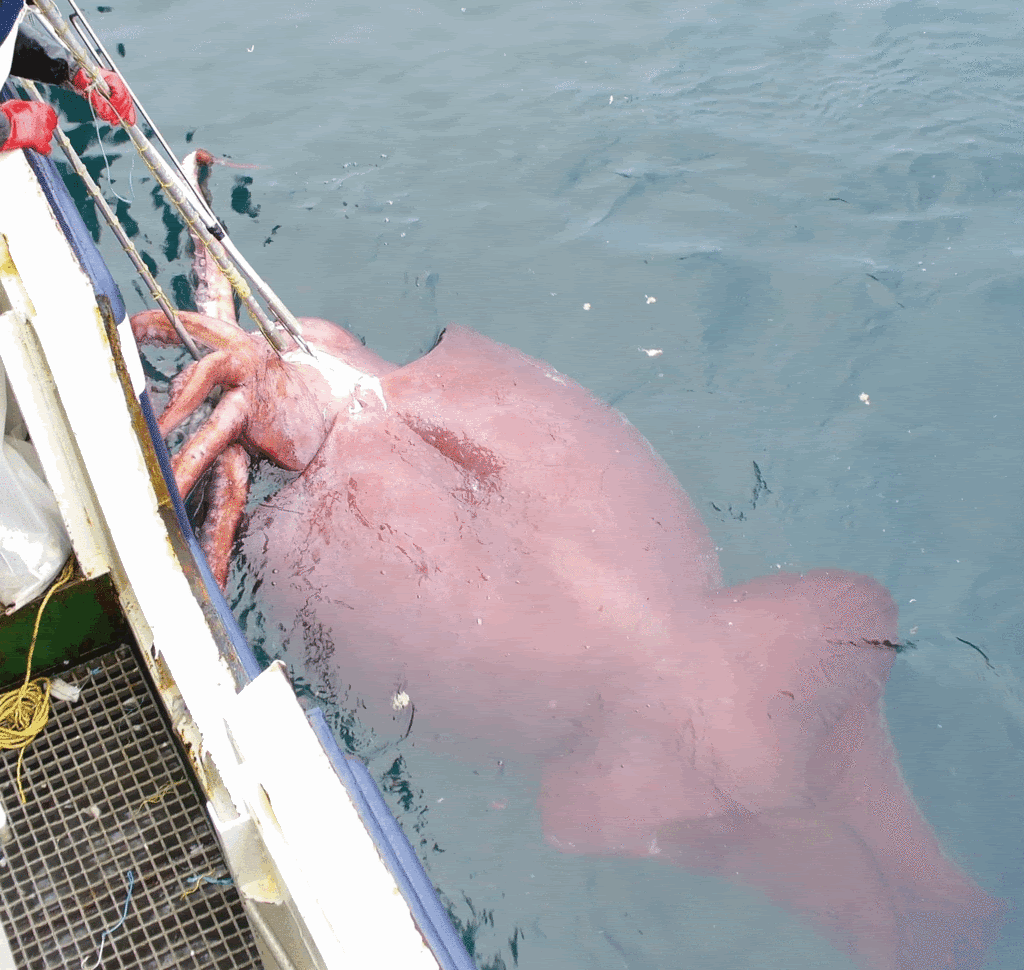


It is exceeded only by the colossal squid, Mesonychoteuthis hamiltoni, which may have a mantle nearly twice as long. The giant squid is the second-largest mollusc and one of the largest of all extant invertebrates. Much of what is known about giant squid age is based on estimates of the growth rings and from undigested beaks found in the stomachs of sperm whales. The age of a giant squid can be determined by "growth rings" in the statocyst's statolith, similar to determining the age of a tree by counting its rings. Like all cephalopods, giant squid use organs called statocysts to sense their orientation and motion in water. The solution tastes somewhat like salty liquorice/salmiak and makes giant squid unattractive for general human consumption. This differs from the method of flotation used by most fish, which involves a gas-filled swim bladder.

Giant squid and some other large squid species maintain neutral buoyancy in seawater through an ammonium chloride solution which is found throughout their bodies and is lighter than seawater. The giant squid probably cannot see color, but it can probably discern small differences in tone, which is important in the low-light conditions of the deep ocean. Large eyes can better detect light (including bioluminescent light), which is scarce in deep water. It also has the largest eyes of any living creature except perhaps the colossal squid-up to at least 27 cm (11 in) in diameter, with a 9 cm (3.5 in) pupil (only the extinct ichthyosaurs are known to have had larger eyes). The giant squid has a sophisticated nervous system and complex brain, attracting great interest from scientists. The beak of a giant squid, surrounded by the buccal mass The bases of all the arms and tentacles are arranged in a circle surrounding the animal's single, parrot-like beak, as in other cephalopods. The manus is broader, closer to the end of the club, and has enlarged suckers in two medial rows. The carpus has a dense cluster of cups, in six or seven irregular, transverse rows. Įach tentacular club is divided into three regions-the carpus ("wrist"), manus ("hand") and dactylus ("finger"). It is common to find circular scars from the suckers on or close to the head of sperm whales that have attacked giant squid. The perforation of these teeth and the suction of the cups serve to attach the squid to its prey. The circumference of these suckers is lined with sharp, finely serrated rings of chitin. The inside surfaces of the arms and tentacles are lined with hundreds of subspherical suction cups, 2 to 5 cm (0.79 to 1.97 in) in diameter, each mounted on a stalk. The vertical distribution of giant squid is incompletely known, but data from trawled specimens and sperm whale diving behavior suggest it spans a large range of depths, possibly 300–1,000 metres (980–3,280 ft). Specimens are rare in tropical and polar latitudes. It is usually found near continental and island slopes from the North Atlantic Ocean, especially Newfoundland, Norway, the northern British Isles, Spain and the oceanic islands of the Azores and Madeira, to the South Atlantic around southern Africa, the North Pacific around Japan, and the southwestern Pacific around New Zealand and Australia. The giant squid is widespread, occurring in all of the world's oceans. The first images of the animal in its natural habitat were taken in 2004 by a Japanese team. The number of different giant squid species has been debated, but genetic research suggests that only one species exists. Claims of specimens measuring 20 m (66 ft) or more have not been scientifically documented. The mantle of the giant squid is about 2 m (6 ft 7 in) long (more for females, less for males), and the length of the squid excluding its tentacles (but including head and arms) rarely exceeds 5 m (16 ft). It can grow to a tremendous size, offering an example of abyssal gigantism: recent estimates put the maximum size at around 12–13 m (39–43 ft) for females and 10 m (33 ft) for males, from the posterior fins to the tip of the two long tentacles (longer than the colossal squid at an estimated 9–10 m (30–33 ft), but substantially lighter, as the tentacles make up most of the length ). The giant squid ( Architeuthis dux) is a species of deep-ocean dwelling squid in the family Architeuthidae. Worldwide giant squid distribution based on recovered specimens


 0 kommentar(er)
0 kommentar(er)
